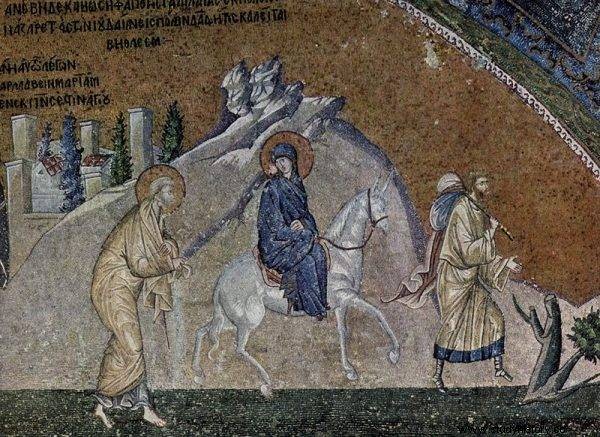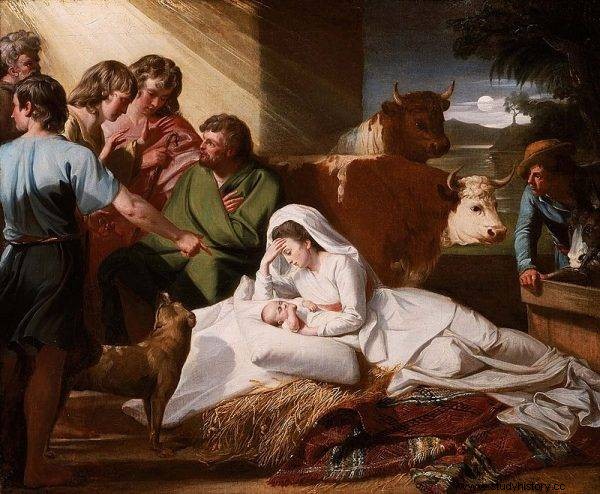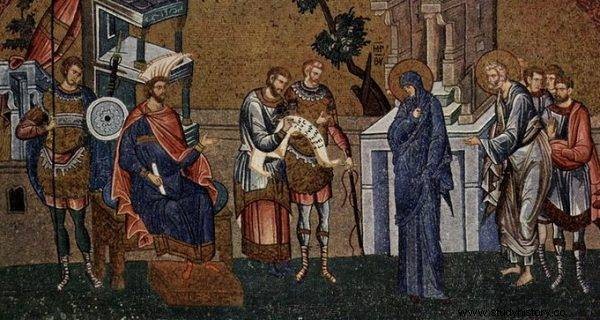According to St. In Luke, Jesus was born at the end of the Holy Family's journey to Bethlehem, where Joseph was to take part in ... a census.
How much in the story of Christmas according to St. Luke is historical truth? Researchers admit that the Quirinius census did take place. The problem is, Jesus was in his teens by then. Skeptics accuse the evangelist of a lie. In their opinion, he made everything up. Some scientists, however, believe that he was simply wrong. There are also those who believe that the facts Luke gave and their chronology are in line with historical truth. The evangelist described the events culminating in the birth of Christ:
At that time, Caesar Augustus ordered a census of the whole country. This first census took place while Quirinius was governor of Syria. Everyone would go to register, each to their own town. Joseph also went from Galilee, from the city of Nazareth, to Judea, to the city of David called Bethlehem. because he came from the house and family of David, to be signed up with Mary, who was pregnant with him . While they were there, it was time for Mary to be delivered. She gave birth to her firstborn son, wrapped him in swaddling clothes and laid him in a manger, because there was no place for them in the inn.
Date dispute
Publius Sulpcjusz Quirinius, an ambitious and meticulous clerk of Caesar Augustus, was commissioned by his superior to clean up the ethnic tribes of Judea, Samaria and Idumea - Herod Archelaus, one of the two sons of Herod the Great. He was banished by the emperor at the request of the provincial people who accused Archelaos of tyranny and cruelty. Augustus joined Judea directly to Syria and appointed Quirinius the new governor of the province. The historian Josephus Flavius wrote in his Jewish War :
Meanwhile Quirinius was one of the men sitting in the senate (...). He was sent by Caesar to judge matters in the nation and conduct an inventory of estates . (...) Quirinius himself also came to Judea, which was annexed to Syria, to carry out an inventory of properties and sell Archelaus' property .

Joseph and Mary traveling to Bethlehem for the census
Censuses in Roman times were held regularly. Their goal was not only demographic issues - such as the size and ethnic composition of the province, but also - and perhaps most importantly - determination of the wealth of the province's citizens and estimation of the taxes that can be obtained . Men aged 14 to 65 and women aged 12 to 65 paid poll tax - tributum capitis.
The problem is that in the story of St. Luke does not agree with the basic fact. When Quirinius was governor of Syria and the census was carried out, Herod the Great had been dead for 11 years, and Jesus - son of Mary and Joseph - should have been at least 12 years old. The census of Quirinius took place in the 7th year of our era, while we know from the New Testament records that Jesus was born in the reign of King Herod. So it was in the years 8-4 BC.
Invention?
Critics believe that St. Luke may have made up a story about the Holy Family's journey to Judea. What for? The Evangelist recalls that Joseph "went from Galilee, from the city of Nazareth, to Judea, to the city of David, called Bethlehem, because he came from the house and family of David, to be enrolled with Mary, who was pregnant." The key to the eventual fabrication of this story is coming from "the house and family of David," and therefore from the royal family. This association of Jesus with King David may have been a deliberate maneuver. It would both ennoble him as the protagonist of the story and justify Jesus as the Messiah, the liberator of the Jewish people from Rome.
List, but which one?
But perhaps the truth is more prosaic. The evangelist may have simply mistaken the time when Quirinius - as governor of Syria by the will of Caesar Augustus - conducted the census. If so, however, what was the census taken by Joseph and pregnant Mary? Some historians are inclined to argue that St. Łukasz did not mix up the chronology, and mentioned another, earlier list. This is also supported by the fact that Joseph and Mary, as inhabitants of Galilee, would not have had to participate in Quirinius' census in Judea after Archelaos was exiled . At that time, Galilee belonged to Herod Antipas, the second son of Herod the Great.

It may have been a deliberate link between Jesus and King David.
So has there been any other census that forced the Holy Family to travel? The evangelist writes that "the first census took place while Quirinius was governor of Syria." According to the researchers, the word "first" (Latin prote ) can also mean "earlier", "previous ". The whole sentence could therefore be alternatively translated into:"The Holy Family set off for an earlier / first census before Quirinius became governor of Syria" or:"The census took place before Quirinius became governor of Syria." This is a hypothesis that not all experts support. If, however, this is what the record of St. Luke, the whole thing becomes logical.
For Caesar Augustus was actually supposed to plan a census throughout the empire. One of the censuses took place in 8 BCE. and showed over 4.3 million Roman citizens. But could Rome have ordered the census carried out in a formally independent state such as the kingdom of Herod the Great? The researchers' opinions are divided on this issue. Some believe that Rome had no legal basis for this and did not apply such solutions. Others indicate that in fact the kingdom of Herod - "the king by the grace of Rome" - was a vassal state, completely dependent on the will of the emperor, so it would not be a problem to order such a census.
St. Luke the Infallible?
Or maybe we shouldn't interfere with the translation, because Luke meant exactly what he wrote? In 7 BCE the governor of Syria was not Quirinius, but Sencius Saturnin. This is confirmed by the Christian writer and historian Tertullian, who had access to Rome's documents. He admits that the census actually took place, but during the reign of Saturnin in Syria. He also notes that the Roman archives contain "the most faithful testimony of the Nativity of Christ". So, is St. Luke made a mistake not with the dates but with the name of the governor of Syria under whose rule the census was organized in Judea?
Not necessarily. It is possible that Quirinius may have managed the province twice. Some sources indicate this. It is about the so-called an inscription from Tivoli, i.e. an inscription engraved on the so-called Stone of Tiberia - an epitaph created after the death of Emperor Augustus. It mentions the glory of one of the dignitaries of Rome, who during the reign of Augustus twice - in exchange for merits - served as the governor of Syria. According to some researchers, it was supposed to be Quirinius.

Mary and St. Joseph enrolled in the census before Governor Quirinius
According to William Ramsey, the future governor of Syria was to temporarily co-govern the province together with its "main" legate Sencio Saturnin. When the Homonadensian tribe broke out in neighboring Cilicia, the attack probably came from two sides - from Galatia and Syria. Quirinius could then act as Syria's legate for military affairs, while Saturnin administered the province and was responsible for the census. With this assumption, St. Luke would not be mistaken when he wrote about the great governor of Syria, Quirinius, and his story would be fully consistent with the historical truth. Was it really so? Hard to say. Certainly, Luke's gospel will be repeatedly analyzed in terms of the available knowledge about the era in which Jesus Christ was born.
Bibliography:
- Raymond E. Brown, The Birth of the Messiah, Doubleday 1977.
- Aleksander Krawczuk, Herod, King of Judea , Warsaw 1988.
- Adam Ziółkowski, History of Rome , Poznań 2005.
